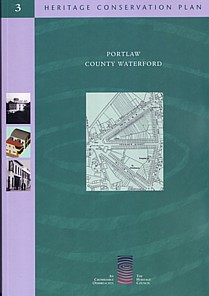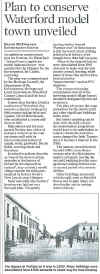Exciting Times for the village of Portlaw
Following a couple of years hard work Minister Martin Cullen officially launched the Heritage Conservation Plan for Portlaw, before an invited guest list in the splendid and appropriate venue of Woodlock. The culmination of the launch was the uplifting presentation by the curator of New Lanark in Scotland, Mr. Jim Arnold. This is a village which is very similar to our own village and in the space of thirty years has gone from a derelict site to a major tourist attraction and listed as a world heritage site. It has shown us that it can really be done.
The actual plan is a most impressive document and contains a wealth of historical information. Below is the introduction to the plan.

INTRODUCTION
The town of Portlaw is located in County Waterford on the north bank of the Clodiagh River just 13 miles north-west of Waterford City. With an interesting and important history, it owes its existence in large measure to the great 19th-century industrialist, David Malcomson, and his establishment of a cotton mill in the town in 1825. The factory that Malcomson built represented a remarkable achievement for its time: a large and innovative structure formed the centrepiece of an interconnected system of canals, weirs, gas works, bleach fields, weaving sheds and foundries. In short, the development of the cotton mill and its support facilities at Portlaw is one of the more exciting episodes in the history of industrial development in Ireland.
However, there is another aspect of the Portlaw story which is perhaps even more interesting than the cotton mill itself. In order to keep the factory supplied with much-needed manpower, the Malcomson family created a Model Village outside its gates - a social and town planning experiment in which the employer took on the responsibility for most aspects of the welfare of the workforce. 'Model' or 'Company' towns were significant innovations in urban planning, particularly in the great industrial centres of England and North America. While, strictly speaking, Port[aw wasn't the first such town to have been founded in this country (religious and other types of 'Utopian' settlements had been established in the 18th century), it is the most significant in terms of its scale and sophistication. It is also the one model development in Ireland which matches the level of achievement of the world-renowned villages found in England, Scotland and America (Saltaire, New Lanark or LowelI, for example). In fact, it is traditionally held that Portlaw was the probable inspiration for the Cadbury brothers' marvellous village of Bournville (outside Birmingham), a development thought by some to represent the pinnacle of this form of social and urban planning.
While the industrial complex and the model development alone should be enough to ensure the town's historic significance, Portlaw has yet more important features:
The workers' housing was [aid out on a Baroque plan, with streets radiating from a central square. This type of town plan is rarely deployed in Ireland.
The houses were finished with a Portlaw Roof - the gently curving, timberframed structure which is, perhaps, Portlaw's most striking architectural feature.
A series of large houses, commissioned by members of the Malcomson family on the periphery of the town, has resulted in. a concentration of high quality work by the architect J.S. Mulvany, one of the most important mid 18th-century Irish architects.
Portlaw’s auspicious rise occurred relatively quickly (1825 to 1870). Sadly, it has longer periods of economic depression and neglect. After the collapse of the Malcomson empire in the 1870’s, the cotton mill fell into disuse and all of the machinery it housed was either sold for scrap or shipped away. Many of the houses of model village fell vacant and were eventually demolished. An effort to turn the town's fortunes around resulted in the establishment of a large the old cotton mill in the 1930’s. This venture proved a mixed blessing while new investment brought about a much-needed revival of the towns economic fortunes, it also contributed to the loss of a great deal of fabric from the earlier cotton mill period. There was another unfortunate consequence in that the tanning industry generated a large amount of chemical and other waste, much of it still buried in and around the factory buildings. Like the earlier cotton factory, the tanning business, too, eventually failed, and has returned to yet another prolonged period of economic decline. However despite despite difficult times, some of the built fabric from Portlaw's cotton mill still survives. Because this represents the physical manifestation of an important element of our shared cultural heritage, it is essential that we consider ways in which this fabric can be secured. It is against this background that, in 2001 the Heritage Council of Ireland, working with Waterford County Council the Department of the Environment and Local Government, commissioned a Conservation Plan for the town of Portlaw.
THE CONSERVATION PLAN
It is easy to aspire to the conservation of something which we consider valuable; it is far more difficult to put the framework in place to ensure its conservation. This is particularly so in the case of Portlaw, comprising as it does such a large variety of structures and other artefacts, each contributing to the town's historic importance in a different way.
There is another practical difficulty faced when the subject of a conservation initiative includes a vast, disused industrial building. Such projects inevitably require the investment of large amounts of capital. Investment on the scale required may only be available if a certain amount of change can be accommodated. The challenge, then, becomes to find ways in which necessary change can occur while causing minimum toss of significance to the object we've set out to protect.
In recent years, the problem of managing change in historically sensitive environments has been addressed in a process now widely referred to as Conservation Planning. First developed in Australia but recently deployed in the UK and Ireland, the Conservation Plan methodology promotes a step-by-step approach to conservation projects that is often summarised as follows:
• Understand the object which you wish to conserve.
• Assess its significance.
• Assess how this significance may be considered vulnerable.
• Write policies to retain the significance
This process calls for the participation of all those who have an interest of the object under consideration and seeks to advance initiatives through consensus and community involvement. The idea is that once the Conservation Plan which addresses the overall situation is in place. specific or actions (management strategies, option appraisals, development opportunities and so on) will follow. In otherwords, the intent is to put the general framework in place which provides a context for specific initiatives down the line
This document represents an attempt to apply the Conservation Planning to the town of Portlaw. It is the result of a prolonged period of research, analysis, discussion, and extensive consultation with the community proposes a structure around which the important aspects of Portlaw can best be secured for the enrichment of the community as well as for the enjoyment of generations.
The Portlaw Conservation Plan has two parts. This publication assesses background to the development of the town, evaluates the overall significance of the place and addresses the most pressing conservation issues that it faces extensive Appendices (available from The Heritage Council) detailed studies, significance matrices and specific initiatives designed context to the policies advanced in this publication.
PARTICIPANTS
The Portlaw Conservation Plan was co-sponsored by the Heritage Council County Council and the Department of the Environment and Local Government
The project team engaged to prepare the Plan were:
Garry Miley, Project Coordinator, Architect and Urban Conservationist
John Cronin, Urban Planner and Conservationist
Mary Steeman, Industrial Archaeologist RPS Environmental Services, Landscape and Ecological Evaluation
McCutcheon Hogan Planning Consultants, Urban Planners
Coverage of the launch taken from Irish Times

